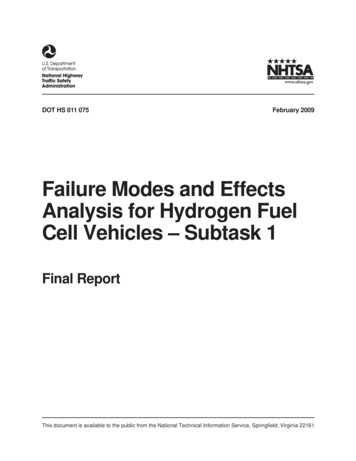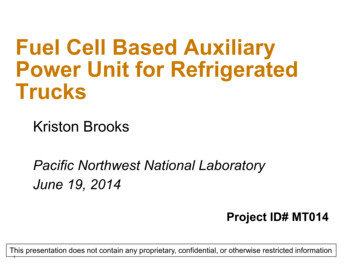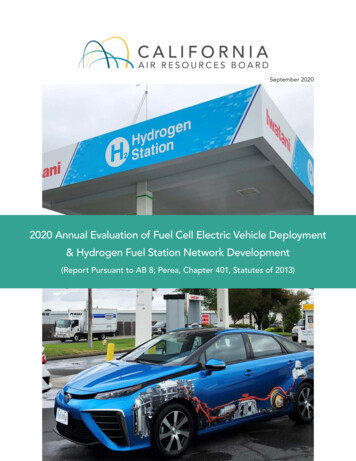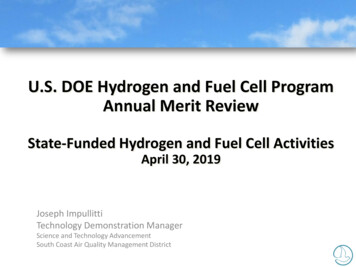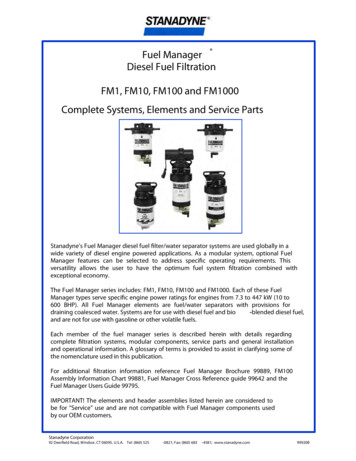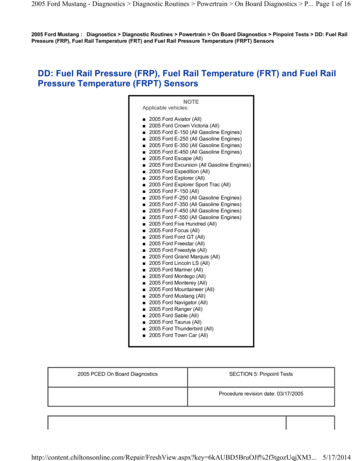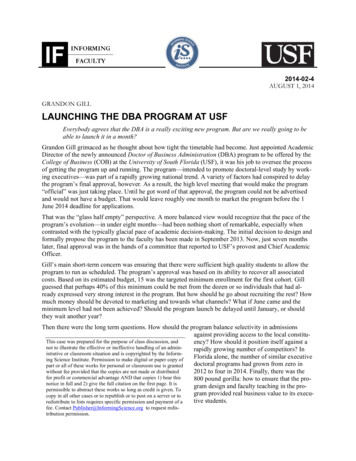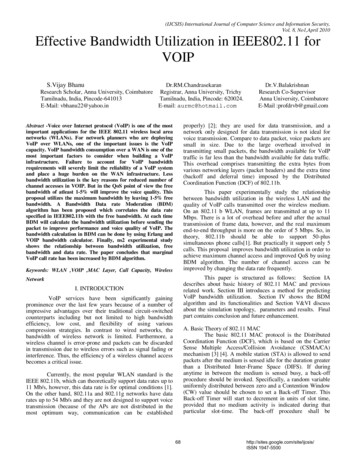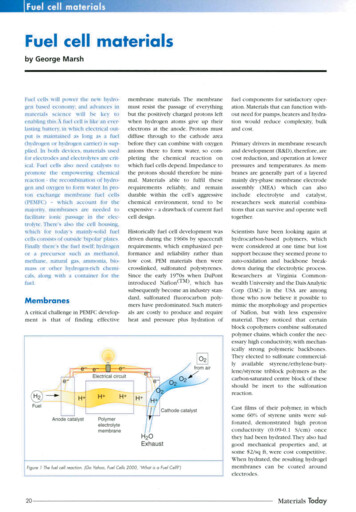
Transcription
Fuel cell materialsFuel cell materialsby George MarshFuel cdb will pow!:!" tilt: neW hydrogen ba:-nl economy: and ad\'anct: inmaleriab :-.ciellet: \vill be kc.:y toenabling lhi .A fud cdl i like an ever·la:Hing batltfY. in which dectrical oul·put i maintained a long a:-. a fud(hydrogen or hydrogen carrier) i :- upplkd. In both dt:\'ict: . 11l:11tTia[ t1:-.edfor declrode and electrOlyte:'! arc: critical. FlIt:1 (db also need cltal ' b topromOle the empowering chemicalreaction - the recomhin:llion of hydrogen and OX en lO form watef. In pro-mcmbrane materials. Thc membranemust resist the passage of everythingbUi the positively charged prolOns leftwhen hydrogen atoms give up theirelectrons at the anode. Protons mustdiffust: through to the c:nhode arC 1before they can combine with o:\"ygt:11anions there to form water. so completing the chemical reaction onwhich fuel cells depend. Impedance tothe protons should therefore be minimal. Materials able to fulfil theserequirements reliably. and remaindurable within the cell's aggressivechemical environment, tend to beexpensive - a dlJ.\vback of current fuelcell design.toll exchange membrane [ud cdb(PE.\lFC) - which account for lhel1l ljority. llH:':lllhrane:-. are needed tofacilitate ionic pa:-,s:lllt: in lhe eketrolylc.:. There' abo the cell hOll:'ling.which [or lOda( mainly-:-.olid fudcdb con b(:o. of outside 'bipolar' pbtt.:::,.Finally (hnc:' tht' fud ibdf: hydrogt.::nor a rrt'cur or :"uch :I:'l 1llt.::thanoLmt'lil:lnc. n:llural g:I:'. ammonia, bioma:,:, or other hydrogen-rich dlt.::micab. along with a container for thefud.HislOrically fuel cell development wasdriven during the 1960s by spacecraftrequiremellls, which emphasized performance and reliabiJiry rather thanlow cost. PEM materials then ,verecrosslinked. sulfonated polystyrenes.Since the early 1970s when DuPoll(illlroduced Nafion(TM). which hassubsequently become an industry standard, sulfonated fluorocarbon polymers have predominated. Such materials are costly to produce and requireheat and pressure plus hydration ofMembranesA critical challenge in PEMFC development is that of finding effective6)-HH H H FuelAnode catalystPolymerelectrolytemembraneFigure I The Fuel cell reoclion. (Go Yohoo, Fuel Cell5 2000, 'Whal ;5 a Fuel Cell?')fuel componems for satisfactory operation. Materials that can function without need for pumps. heaters and hydration would reduce comple.xiry, bulkand cost.Primary drivers in membrane researchand development Ol.&.D).therefore. arecOSt reduction. and operation at lowerpressures and temperatures. As membranes are generally part of a layeredmainly dry-phase membrane electrodeassembly (MEA) \vhich can alsoinclude eltctrolyte and catalyst.researchers seek material combinations that can survive and operate ,veiltogether.Scientists have been looking again athydrocarbon-based polymers. whichwere considered at one time but lostsupport because they sec:med prone toauto-oxidarion and backbone breakdown during the electrolytic process.Researchers at Virginia Common·wealth Universiry and the Dais AnalyticCorp (DAC) in rhe USA are alllongthose who nO\v believe it possible tomimic the morphology and propertiesof Nafion. but with less expensivematerial. They noticed that certainblock copolymers combine sulfonatedpolymer chains. which confer the necessary high conductiVity. \vith mechanically strong polymt'ric backbones.They elected to sulfonate commercially available styrene/ethylene-burylenc:/sryrene triblock polymers as thecarbon-sarurared centre block of theseshould be inert to the sulfonationreaction.Cast films of their polymt:f, in whichsome 60% of styrene units were sulfonated. demonstrated high protonconductiVity (0.09-0.1 S/cm) oncelhc:)' had been hydrated. They also hadgood mechanical properties and, atsome S2/sq fL. were cost competitive.\V'hen hydrated. the resulting hydrogelmembranes can be comed Houndekctrocks.2 0 - - - - - - - - - - - - - - - - - - - - - - - - - - - - Materials Today
. :,Fuel cell materials Such technology has enabled DAC,for one, to market :1 range of compel-ilive hydrocarbon membranes andMEAs.1\vo differenl membrane materials, with 57·63% 5ulfonalion levels,are available in pre-cast solid flake orin-solution form. Both materialsexhibit good cation exchange ability,optical transparency and wateruptake capability. Cast films have anion conductivity (when fully hydrated) of 0.09 S/CI11, comparingfavourably with conductivity of fluo-Bipolar PlateContact LayerCathode \ProtectiveLayerElectrOIY Anoderocarbons.00 60 0oOo;?c--o0"-- 0-Relatively lo\v-cost mcmbr.l.I1cs are ecn[ral 10 DACs production of 25·200 \Xlair-cooled PEM fuel cells. and small'passive' cells with 110 moving partswhich run from hydrogen cylinders at/Oxidant GasSupplyPorous 5000 0000- sealantLayerSUbstrat ,.-;,.-;,.-;,.-;vFuel Gas Supply1mv pressure and at 35-70 C. DAC hasrecently been awarded contracts fromthe US National Science Foundationfor material COSt reduction studies,from the US Department of TransportFigure 2 (Fuel Cells Bulletin No I A), Principle of SOFC design occording to DLR sproy concept.for a diesel fuel cell demonstration,from the Electric Power ResearchInstitute to continue a residential fuelcenrers, usingcellsbasedonphosphoric acid electrolyte.Thc::se larger stacks, generating 250 k\V em gen-dissociate if allo\Vc:d ro cool belO\v42 C.cell program, from Hamburg GasConsultants for small stationary powerunits, and from a range of laboratories,erate electricity at over 40% efficiency.rising to nearly 85% if steam the cellHigher efficiencies still art" offered bybusinesses ancluniversities for fuel cellproduces is used. via a turbine. for cogeneration.research.Different plastics are required forCanadian company Ballard PowerSystems. arguably the world's leadingmanufacturer of cells for stationaryand mobile applications, is also working on affordable material technologies for low-temperature PEMFCs. ItsMark 900 fuel cell for instance, introduced to the market a year ago. hasbeen conceived for serial productionin the automotive industry andhigher temperature and pressureoperation. Celanese, for instance, usesmembranes of polybenzeimidazole(POI) in automotive fuel cells it isdeveloping in collaboration withHonda. Celanese solid-OXide/polymermembranes will also be part ofHonda-produced l\llEAs.Electrolytes900 cells and Daimler Benz, whichalso has an alliance with the compa-Cells that run at elevated lemperaturesare pOtentially mOre efficient than low-ny, expects to mass produce a fuelcell car within four years. Ballardrecently commissioned a 110000 sqtemperature devices, and can moreeasily 'digest' hydrogen-containingfuels like methanOl, natural gas,ftfacilit)' atBurnaby, BritishColumbia, lO manufacture itS fuel cellmethane and diesel. Low-temperaturecells, in contrast. normally need ratherrange.pure hydrogen. The phosphoric acidcell (PAFC), typically running at some200 C, has rcached a high level ofature cells. \\lith European partnerAlstom it is - over two years - helpingro implement demonstration projectsin Berlin, Bask and six other EuropeanMaterialsTodayselves to direct use of precursor fuels.like methanol. in direct fuel cells(DFCs). Full-scale molten carbonatestacks were demonstrated in Californiain the mid-1990s. Leaders in lhe MCFCfield are FueiCell Energy in the US withits Direct Fuel Cell (DFC) system andGerman partner MTU with its HotModule version. There are alsoJapanese demonstration systems inKawagoe and Amagaska.Hotter still at around 980 C, solidutilizesinexpensivematerials.Nissan has since taken delivery of MkBallard is also active in higher-temper-molten carbonate cells operating ataround 650 C Again, these lend them-technological and commercial developmel1l and already powers hospitals,schools and utility plams. Phosphoricacid is bound in a gel matrix - but willoxide fuel cells can approach 60%power generalion efficiencies (wit hout co-generation). A hard ceramicoxide. typically yttria-stabilized zirconia (YSZ). disposed in a tubular arrayor as a compressed disc. is the electrolyte. Tubular SOFCs with microturbine co-generation, are currently beingbuilt by Siemens \Vestinghollse PowerCorp for European utilities R\VE PowerAG of Germany and Edison SpA ofItaly These pre-commercial systemswill develop 300 k\'Y. Combinationwith a gas turbine significantly increases overall system efficiency. a criticalfactor in larger power generation-----------------------------21
Fuel cell materialsprocess, which I3cks intermediate sintering steps, lends itself to continuous.f:lst automated production. Eleclrolytes with enhanced ionic conductivity. such as scandia-stabilized zirconia (ScSZ). doped ceria or dopt:d lanthanum gallates are used.ScreenprintingTape castingMuch research is now taking placeworldwide on 100ycr (illlermediate)temperature SOFC materials andstructures. Other research group in Europe and USA are seekinglarger·scale semi-automated manufacture of SOFCs too. NOlahly. LheNetherlandsEnergyResearchFoundation (ECN), has launched a - II"subsidiary.lnDEC Pilot Production B\Zspecifically to do this.SinteringFigure 3 (Fuel Cells Bule/in No 14) InDEC Pilof Production BV's advanced monulocluring syslemforSOFes.Electrodes and catalystssystems. A demonstration 220 k\'Velectrode assemblies are engineeredSiemens co-generation system with ato prOVide the support instead.NexTech is currently producing electrode-supported planar elements by10W-COSL fabrication routes. First themicfmurbine is now running atthe National Fuel Cells ResearchCenter at the University of California.Irvine.Other ceramic dectfolytes used inSaFes include scallclium-doped zirconia,samarium-dopedceria,andgadolinium-eloped ceria. Among companies producing such materials ( :ISwell as YSZ) are US concern NexTech.which markets them as nalloscalepowders and in aqueous suspensions.This company also produces a range ofceramic perovskite (oxides of lanlhium compounded \vith gallium scandium, indium and aluminium) cathodematerials. Doped lanthium gallate alsoappears to show promise as an SOFesolid electrolyte,SOFC developers, conscious of anintensely competitive energy marketplace, are working hard to reducecosts. One research thrust is to findalternatives to the expensive electrochemical deposition process by whichplanar film elements have gtnt:rallybeen formed to date, In particular, newways are sought to deposit electrolytefilm very thinly so that ohmic lossescan be minimized.Film less than 50longerbe lInLhick can nose If-su ppOrL i n ,socathode, comprising lanthanum manganite tubes which are both porous toallow for Lhe passage of fuel gas andSLiff enough to proVide support. isformed by tape casting. NexTech thenuses a colloidal deposition and sintering process to lay down YSZ electrolyte film onto the cathode. Finally.the opposite electrode is formed byscreen printing. NexTech says itsprocess allows for rapid deposiLion offilm thal can be sintered to high denSity without formation of cracks, pinholes and oLher ddects.Moreradically, Germanaerospaceresearch body DLR has developed anovel thin planar SOFC concept LhaLreduces both production COSL andoperating temperature - to around800 C. The more forgiVing thermalregime will make it possible to usecheaper interconnect materials. suchas ferrilic steds. withoUl protectivecoatings - and should prolong cellservice life.In DLR's process the anode. electrolyteand cathode layers are sequentiallydeposited, by advanced vacuum plasma spraying, onto a porous metallicsubstrate about 1 mm thick, ThisLike batteries. many fuel cells havegraphite electrodes. though .vith theaddition of a noble metal such as platinum to catalyze the chemic.al reaclion, These metals are expensive. andtend to emanate from few sources incountries which may not be theworld's most stable. In seeking alternatives, researchers h:we been assessing the performance of certain lessnoble and more accessible metals.Alkaline fuel cells specialist ZeTek in('he UK, for instance. has been investigating cobalt and other similarmet.lls.Another issue is that these expensiYcmetals can be 'poisoned' by carbonmonoxide produced as a by-product ofthe fuel rdorming process (generatinghydrogen from a precursor fuel). DrAndrea Russell from SouthamptonUniversity. UK. has used X-ray synchrotron radiation to investigate whichmaterials will serve best as catalysts inPEMFCs. without their operation being'poisoned' by cubon monoxide produced as a by-product of the fuelreforming process (generating hydrofromaprecursorfuel).genInvestigations of catalysts made withplatinum and well-mL.'Xed alloys ofplatinumandrutheniumrevealan improved tolerance to Co.T IJ Technologies. which produces catalyst supportS from carbides and2 2 - - - - - - - - - - - - - - - - - - - - - - - - - - - - - MaterialsToday
. .Fuel cell materials nitrides, claims that early transitionmetal carbides can increase carbonmonoxide tolerance and improvenoblemetaldispersion.finds that metalTIl alsoplhalocya 1inecom-pounds can lIsefully reduce noblemetal loadings. The company, whichclaims superior performance for itse1eCtrOC;llJ.lYSIS, has also developedlowerthem.COStmethods for producingas batch. semi-automated production of thin pl,lIlar eleClfolytes canhelp reduce fuel cell costs, eleClrodesand catalysts - the latter particularly can similarly be made as planar films.DLH, for instance, has reducedJUStamountsof noble metal cHalys!needed in MEAs for PEM and directmethanol fuel cells (DMFCs) to0.05 mglsq em or less, by engineeringextremely thin reactive layers. A thinlayer tends. in any case, to be moreefftciem because it promotes reactionand allows the passage of productwater.Figure A Slationary Fuel cellsPlanar MEAs can. like electrolytes, beproduced by dry-coat plasma spraydepOSition. Again, such methods canimprove on cOl1veI1lional preparation from colloidal suspensions ofcarbon black, catalyst. PTFE and electrolyte. Materials for ultra-thin electrodes and catalyst are alOmized andsprayed in a nitrogen stream OntO amembrane. Deposited layers are thenfixed, followed by a rolling or horpressing stage to enhance ionic contact. By varying powder compositionand deposition conditions, this flexible process can be optimized fordifferentproductsPEMFCsandDMFCsforexample. Nodrying steps are necessary. sofareheavyFigure 5 Single Bollard Fuel Cell.metals are low.proprietary additive to the active layerAnotherway toreducetransportof platinum catalyst in a Nation-basedresistanCt: occurring in the electro-MEA. along with externally humidifiedchemical reaction is to increase porevolume in gas diHusiol1 electrodes.reactant gases, yielded performancehikes of up ro 40%. A further improve-\'(forkersforment was to change the substr::lte layeratElt:ctrochemicaltheCenterSystemsPTFE and acetylene black similarlypainted.Bipolar platesandof the electrodes to increase tht: levelThe ollter layers of a planar fud cdlHydrogen Research at Texas A&Mof water taken up in the electrode andconvey hydrogen and air. respectivelyUniversity have dt:veloped pore forming additives for the purpose.membrane. Various polymer/carbonblack mLxtures painted onto a carbonto the anode and Glthode. via chan-Incorporating 20-60% by weiglll ofcloth replaced the older mix of 35 wt%nels moulded Or cut into the pl ltes. aswell as supporting the cell structure.Materials Today - - - - - - - - - - - - - - - - - - - - - - - - - - - - - 2 3
.:1Fuel cell materialsMaterials used for these 'f1ow field' or'bipolar' plates must combine themechanical strength and elasticity totoler-He assembly and stack conditions with low weight, electrical COI1ductivity, low permeability and highcorrosion resistance. Less costly alternatives are sought to present graphiteplates which arc brinle and hard tomachine. To have sufficient fractureStrength, plales muSt be several millimeters thick. making fuel slackshea\'ier and bulkier than necessary.Some research is aimed at improvingIhis situation. For example, EnergyVentures Inc (EVl) is collaboratingwilh TDM LLC to develop cost-effective graphite flow plales for use inEVI's direct methanol fuel cells. Alsoinvolved are the National ResearchCouncil of Canada and the Universityof Guelph.Metals, especially stainless steel. havebeen suggested as alternatives tographite. The Netherlands EnergyResearch Foundation (fCN) has triedthin stainless stee! sheet but finds thatstainless constituenrs slowly dissolveinto the MEA. especially on the anodeside, reducing performance. However,the researchers suggest that, withproper pre-treatment and use of a gasket to prevent direct contact betweenthe stainless steel and the membrane,certain stainless alloys are suitable forlow-cost PEMFCs.Researchers at Los Alamos NationalL1borarory in the US suggesL. howev ::r.that vinyl ester thermoset resins ;lresuitable for bipolar plates. Th ::semethacrylated epo.x)' difunctionalpolyesters (half pOlyester, half epoxy)are strong. tough, light. corrosionresistant and available at 100v cost.Given use of free-radical initiators likeorganic peroxides or azonilriles, along,vith appropriate accelerators. theypolymerise quickly. The Los Alamosteam identi.f1ed a carbon powder withconsistent particle size that offers highconductiviry for a given volume fracLion, and combines re:ldily '.ith liqUidvinyl ester resin to form a homogenouscompression-moldablecompound.Plates containing 68 wt% carbonexhibited bulk conductiviti ::s of60 S/cm or higher, while flexur:llstrengths were high. No measurablehydrogenpermeationoccurredthrough the plates. Test material performed IS well as machined carbon inactual fuel cells. Processing is relativelysimple and cheap.It may be possible to reduce carbonlevels since recent work suggests thaIcell performance is not thereby greatlydegraded. If this were to be so.improved strength and processabilitywould result.Additives can be used toenhance surface hydrophobicity. \'\lorkto optimize the material as ,1 baselinechoice for PEMFCs continues.More promising, perhaps, is the possibiliry of using carbon/polymer composites.These could be light. more easily manufacrured - \vith flow channelsmoulded in from the start - and oflower cost.Commercial company Plug Power LiCcontributes to this on-gOing research,which is funded by rhe US Departmentof Energy's Office of AdvancedAutomotive Technologies.Experimenters have typically triedusing thermoplastic matrices such aspolyethylene,polypropyleneorpolyvinylidene fluoride (pVDn with aconductive carbon Hiler - possibly alsowith short carbon fibers for reinforcement. But thermoplastics have costandcycletimedisadvantages.Thermoset resins - pOlyesters, epoxies. phenolics etc - offer shorter moldcycle times but require heat and vaculUll assisted cure cycles. Injectionmoulding is made difficult by thesolids loading needed to provide conductiviry.StorageA h)'(lrogen economy cannot flourishulllil adequate Stor.lge technology isdeveloped. Hydrogen can be stored inconventional metal cylinders at pressures around 400 bar (with up to 700projected). but transport applicationsrequire lighter storage, rypically in filament-wound glass, aramid or carbonreinforced epoxy composite cylindushaVing stainless steel liners. DynetekIndustries.withtheAdvancedLightweight Fuel SlOrage System it issupplying for th :: Niss:ln Xterra fuelcell \'ehiclc, is on :: example of :lCti'·it ·in thiS area. Hydrogen elt1 also beston:d cryogenically at lower than -235 C.An interesting altern:llive to theseknown methods is 10 store the hydrogen as a metal hydride. Gfe MetalleUnd Materialien in Germany. for example, claims that reversible metalhydrides permit storage of hydrogen ina compact. safe: and cOl1venknt manner. at pressur ::s only slightly abovenormal atmospheric.The G ::rman COIllp,lt1y uses stainless steel for the bodksof its cylinders and :l proprietary met:ll:tlloy hydride. Although energy storagedensity is low. the method rates highl
:, Fuel cell materials Figure 2 (Fuel Cells Bulletin No IA), Principle ofSOFC design occording to DLR sproy concept. Protective Layer- seal

